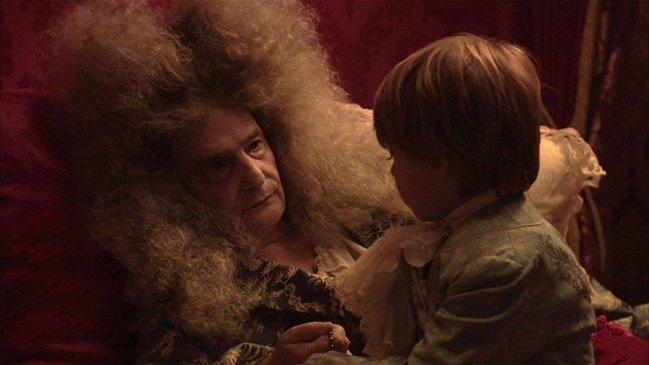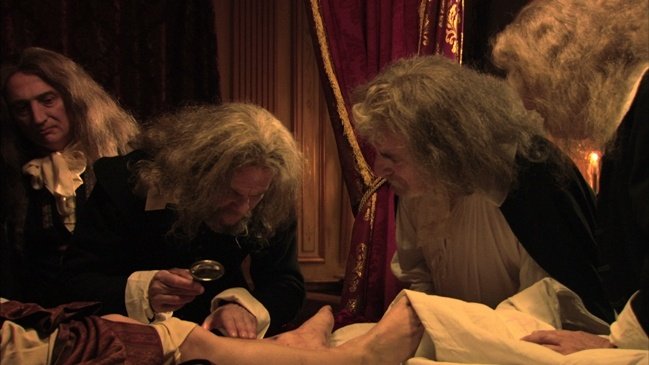
The contrast between absolute power and total impotence is the thematic core of Albert Serra’s latest portrait, The Death of Louis XIV.
“Even the powerful have a lot to lose,” says the Catalan auteur about the extreme situation he devised in the film, which observes the divide between what “one has here on earth and what one has afterwards”—which, he believes, is nothing.
Previously, Serra dealt with the passing of another historical figure in his 2013 feature Story of My Death. In that narrative he juxtaposed the iconic Italian lover Casanova with a powerful fictional figure, Dracula, creating a dialogue about immortality. On the other hand, Louis XIV is a more intimately rendered look at a decaying monarch set entirely in his bedroom.
Though drawing parallels between the two films is tempting, Serra is very clear about their distinctions. “The previous film was not about the death of Casanova itself. It was more on the symbolic side, and about the death of a period in history, not only about him.”

Director Albert Serra
Louis XIV, the French monarch also known as the Sun King, boasts the longest reign in European history (lasting over 72 years, from 1643 to 1715) and is credited with transforming Versailles into a royal palace. Those facts, however, were not at the center of the director’s interest. “That somebody is historically famous or historically relevant doesn’t mean he interesting,” he says. “For me it’s more about dealing with the visual aspects. All these things about why somebody is important historically come from literature. All the elements in books, or in history, are not useful for me. My only goal is visual—visuals with time, which is cinema. These ideas can help the dramaturgy of the film, but in general, what creates the extreme quality of film comes from the images themselves. I didn’t want to make a normal academic film about the death of Louis XIV that explains what was happening with the state or with the family. That’s technical information, but it doesn’t create characters in cinema. Those are created by bodies and psychology but without such previous knowledge.”
Serra describes the way he uses history as an “opaque material” that filters reality and changes it from its literal form into an interpretation bearing traces of the facts. Whatever significance these carry remains somewhat irrelevant; he prefers to discover what each part of the film represents during production.
“These traces might be an actor, a piece of décor, or a piece of dialogue, but it’s the material that has to create its own sense during the shooting, and not before. For this reason I use three cameras, long takes, trying to fill these images with meaning at that moment, not before,” he says. Methodical execution allows, ironically, for much more freedom where it matters. “I prefer to be faithful to the performance and—this was also an obsession in my previous films—to create meaning in real time, during the shoot, not before. To really work with what is in front of the camera, not what is behind inside my brain. I always stay faithful to this.”
In the case of Louis XIV, intimacy was the main priority. The image of the untouchable ruler, as seen in paintings and presented in academic texts, melts away, and instead we share his final hours, from his bedside. The king, brought in magnificent fashion to life by French New Wave poster child Jean-Pierre, appears in every single scene, though he remains static for the larger part of the fascinating study.
“Being really close to him, to share his point of view, was very important,” says Serra, “because if you start to shoot scenes where the king is not present, you’d have more information than him. You start having your own ideas about what happened, and you lose a little of intimacy with him because your points of view are not the same. But when the king is in all of the scenes in the film, your information is the same as his. There is no scene without him; you share the same point of view.”

Jean-Pierre Léaud as the dying king in The Death of Louis XIV
Death is universal, and the idea of accompanying a king on his road toward it was the director’s core objective. Serra believes that, thanks to this extreme intimacy and economical design, the film transcends its repetitive qualities. The magic that emerges from not following a blueprint grounded on facts, instead allowing the set and its players to interact without constraints, is what he values the most.
Friends in common led Serra to Léaud, who was attached to play the part from the earliest stages, when the project was meant to be an installation at the Centre Pompidou art museum in Paris. (As a completed feature, the film instead played at Cannes, Toronto International Film Festival and New York Film Festival last year.) Léaud, a reclusive art-house star, gives his best performance since becoming François Truffaut’s muse in The 400 Blows nearly 60 years ago as troubled youth Antoine Doinel. Of the actor, the director says, “I feel close to his honesty and his incorruptibility. He only works with intellectual filmmakers, as he would say.” According to Serra, Léaud’s facial features are indelibly French, a factor that solidified him as the choice for the country’s most famous ruler. In the film, he remains mostly silent, unconscious and immobile as his character’s health deteriorates, but his presence, particularly in a long static shot where he looks directly into the lens, is imposing even in disarray.
“Actors always come to the shooting with ideas, but the director has to pick up these ideas, decide which ones are good, and give them a more original form,” says Serra. “The ideas that actors have in mind are usually very boring, because, in general they are not cultivated people and they do not have deep imaginations. They usually come with clichés, almost all the time. It’s the duty of the filmmaker to escape these clichés and to make it more interesting, and bring in real mystery.” Léaud, fortunately, proved an exception to this. “I have to admit that Jean-Pierre performed in a very deep, sensitive, and especially mysterious way.”
Almost paradoxically, though, Serra cultivates improvisation, and doesn’t feel the need to predetermine lines. “You have something’s concrete, which are the facts and what we have to shoot, more or less, but then everything in terms of dialogue is improvised. You have this balance of having something that is not absurd and that is really close to what happened historically, but at the same time that is free, that is not a cliché, and that has density.”
Over the course of his career (previous films include 2006’s Honor of the Knights and 2008’s Birdsong), Serra has developed an unorthodox—by Hollywood standards—approach to moviemaking that cannot be dissected into definitive terms. Silence and observation are his major tools. He shot Louis XIV in a single location, without marks, without a shotlist.
“The most precious secret of any filmmaker is about directing actors, and it’s difficult to explain concretely,” he says. “My system is basically non-communication, but not only with actors but also with the technicians.”
So Serra directs by focusing either on the dialogue, without looking at the image, or on the image from afar without listening. This practice, he believes, prevents simplistic rationalization. “I never have all the information of what’s happening on set. If I am closer to the action, I turn around with my back to the set and I only listen to the dialogue, but if I want to see what’s going on, I go really far away in order not to listen to the dialogues. I never like to have all the information of the scene. That would make react in a very conventional and predictable way. The meaning of the film has to emerge from the set, not form me. I shoot long takes, never repeating the same take, never rehearsing with the actors, and never making variations. I don’t have monitor on set. I never look at an image from the film before the end of the shooting. This creates an atmosphere where these magical things will appear in the performance.”
Why the three cameras? All the better to capture the random inspirations that occur to his performers, Serra says. “Actors feel freer because they don’t know exactly what each camera is shooting, so they do not establish a relationship with the camera. If there is a single camera there is only one direction, and all the performances go towards that direction, and the risk of the cliché gets bigger. With only one camera you would have to prepare something, because the camera will shoot only one small portion [of the set]. Everything has to be more professional. With three cameras, not preparing shots, everything is chaotic and some crazy things occur.”

The Death of Louis XIV
For such an eccentric filmmaker, the need to be in charge of crucial aspects of his singular process is imperative. With that in mind, the director became the manager of his own production company, Andergraun Films, established by producer Montse Triola. “The producer is an auteur, or should be, because he has to detect what the key point of a film is and the most powerful characteristics of the filmmaker and his style are. The producer has to support the style and that support has to be translated in concrete decisions,” Serra believes.
As the elderly king gets slowly closer to his last breath in the film, unreachable elegance dissolves into relatable anguish. Whatever you think of Albert Serra’s methods, it’s hard to deny that, at least with The Death of Louis XIV, they work. MM
The Death of Louis XIV opened in theaters March 31, 2017, courtesy of The Cinema Guild.

